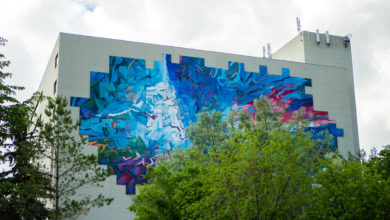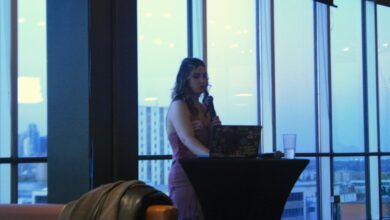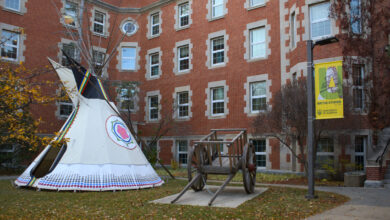The Landing hosts celebration for Transgender Day of Visibility
“The trans community, in my opinion, is such a loving and amazing thing to be able to call home,” organizer says.
 Leah Hennig
Leah HennigOn April 1, The Landing hosted a celebration for Transgender Day of Visibility (TDOV) in the Students’ Union Building (SUB). TDOV takes place on March 31, but The Landing was unable to book a room on that day. The celebration consisted of speeches from community members, as well as the performance of a poem, a song, and a jingle dress dance.
The Landing also tabled in SUB on March 31 with information about trans activists and resources for students.
Sef is an organizer with The Landing and is a third-year physiology student at the University of Alberta. He spoke to The Gateway about organizing the TDOV event.
“I really want to do everything community-based,” Sef said. He said he tries to uplift people in the community who aren’t as established, but are nonetheless talented.
“Inherently, working at The Landing, there’s so many really talented people who just walk through those doors,” he said.
“No one loves like how trans people love each other,” Sef says
Sef started the event with a land acknowledgement and opening remarks. “TDOV is a day to celebrate, love, and pay attention to and cherish transgender people, and just transgender identities in general,” he said.
He spoke to the isolation many feel being trans, but said that that is why TDOV is so important.
“We’re not alone,” Sef said. “In fact, the trans community, in my opinion, is such a loving and amazing thing to be able to call home. No one loves like how trans people love each other.”
Sef spoke to his own experience with his identity as a trans person. He came out in the seventh grade and said he had no trans people around him.
“Entering university was such an amazing breath of fresh air for me, me and my identity,” he said. “I met so many other people like me, and when I came to campus, I was able to unapologetically be Sef, not the name my parents gave me, but the name I gave myself.”
“Visibility matters, visibility inspires,” Allison says
The third speaker was Allison, a trans woman who works at the university. She said she knew she was trans at a young age, but was not able to transition until her 30s.
“As someone who transitioned later than most, I take a pretty literal view of [TDOV],” she said.
“I am an easy target for those who do not support gender-diverse people,” Allison said. “This can take many harmful forms, but those are not what today is about. They have so many other days.”
She said being visibly trans is the biggest gift. Allison said she is seen as a role model just for existing and being visible. “Visibility matters, visibility inspires,” she said.
Allison also spoke to her experiences working in gender-affirming care in Alberta. Being visibly trans means that queer people calm down when they see her, they can ask her questions about gender-affirming care, and don’t have to “be vague about why [they’re] seeing a doctor,” she explained.
She explained the effect her visibility as a “happy, employed” trans person has on parents of gender-diverse youth.
“I see the look in their eyes morph into knowing that their child could still be productive and have a happy life, regardless of their orientation or identity.”
“What I see here is authenticity, vulnerability, uniqueness, and love,” Chantelle says
Southern Thunderbird, or Chantelle, shared their experience as a Two-Spirited person. They spoke about their experience of presenting “very binary.” People assume they are a woman and put them into a box, Chantelle explained.
“I’ve only really been out in the open for the last five years because I only then understood that we could be more than just what people put us into a box,” they said.
“What I see here is authenticity, vulnerability, uniqueness, and love. Thank you for showing us.”
Following Chantelle’s speech, Night Sky Dancer, or King, told the attendees the story behind the jingle dress. They said the jingle dress dance is an Ojibwe dance that originates from a story of a man. The man got older and his daughter got sick. He had a dream of a dress that had 360 cones on it for each day of the year. He made the dress for his daughter, they explained, and she eventually got up and began dancing.
“The more she danced, the more healed she got,” King said. Jingle dress is a healing dance, they explained.
“I wanted to come here and dance for you guys so it can help heal your hearts,” they said. “I didn’t think I’d dance, but I’m here, I’m dancing.”




